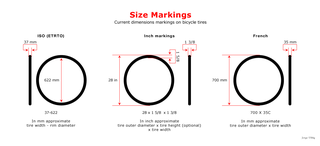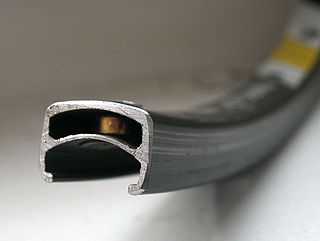
Drag racing is a type of motor racing in which automobiles or motorcycles compete, usually two at a time, to be first to cross a set finish line. The race follows a short, straight course from a standing start over a measured distance, most commonly 1⁄4 mi, with a shorter, 1,000 ft distance becoming increasingly popular, as it has become the standard for Top Fuel dragsters and Funny Cars, where some major bracket races and other sanctioning bodies have adopted it as the standard. The 1⁄8 mi is also popular in some circles. Electronic timing and speed sensing systems have been used to record race results since the 1960s.

A tire or tyre is a ring-shaped component that surrounds a wheel's rim to transfer a vehicle's load from the axle through the wheel to the ground and to provide traction on the surface over which the wheel travels. Most tires, such as those for automobiles and bicycles, are pneumatically inflated structures, which also provide a flexible cushion that absorbs shock as the tire rolls over rough features on the surface. Tires provide a footprint, called a contact patch, that is designed to match the weight of the vehicle with the bearing strength of the surface that it rolls over by providing a bearing pressure that will not deform the surface excessively.

A bicycle wheel is a wheel, most commonly a wire wheel, designed for a bicycle. A pair is often called a wheelset, especially in the context of ready built "off the shelf" performance-oriented wheels.
29ers or two-niners are mountain bikes and hybrid bikes that are built to use 700c or 622 mm ISO wheels, commonly called 29" wheels. Most mountain bikes once used ISO 559 mm wheels, commonly called 26" wheels. The ISO 622 mm wheel is typically also used for road-racing, trekking, cyclo-cross, touring and hybrid bicycles. In some countries, mainly in Continental Europe, ISO 622 mm wheels are commonly called 28" wheels or "28 Incher".

ISO 5775 is an international standard for labeling the size of bicycle tires and rims. The system used was originally developed by the European Tyre and Rim Technical Organisation (ETRTO). It is designed to make tire sizing consistent and clear. It replaces overlapping informal systems that ambiguously distinguished between sizes. For example, at least 6 different "26 inch" sizes exist, and "27 inch" wheels have a larger diameter than American "28 inch" wheels. The Japanese Industrial Standards Committee also cooperates with ISO 5775. The corresponding Japanese standards are JIS D 9112 for tires and JIS D 9421 for rims.

Whitewall tires or white sidewall (WSW) tires are tires having a stripe or entire sidewall of white rubber. These tires were most commonly used from the early 1900s to around the mid 1980s.

This is a glossary of terms and jargon used in cycling, mountain biking, and cycle sport.

Zipp is an American company that is best known for designing, manufacturing, and marketing carbon-composite bicycle wheels for road cycling, triathlons, track racing, and mountain biking. The company's product range also includes handlebars, stems, seat posts, tires, inner tubes, handlebar tape, and bags.

The rim is the "outer edge of a wheel, holding the tire". It makes up the outer circular design of the wheel on which the inside edge of the tire is mounted on vehicles such as automobiles. For example, on a bicycle wheel the rim is a large hoop attached to the outer ends of the spokes of the wheel that holds the tire and tube. In cross-section, the rim is deep in the center and shallow at the outer edges, thus forming a "U" shape that supports the bead of the tire casing.

A run-flat tire/tyre is a pneumatic vehicle tire that is designed to resist the effects of deflation when punctured, and to allow the vehicle to continue to be driven at reduced speeds - under 90 km/h (56 mph) – and for limited distances – usually 16 to 80 km, depending on the type of tire.

The Fire Ball is an amusement ride manufactured by Larson International. It replaced a series of Larson rides manufactured prior to its unveiling, the first being the Super Loops and the second being the Ring of Fire. Several variations of each exist. The rides run the same but the older models have a caged train, whereas the Fire Ball has an open face-off train. Also, some owners of the older Ring of Fire rides have had the caged train replaced with the new Fire Ball train.
The Toyota All-Star Showdown was a nonpoints, all-star race that brought together the top drivers in NASCAR's lower-level series.
Tubeless tires are pneumatic tires that do not require a separate inner tube.

A bead breaker is a tool used for separating tires from rims. The innermost diameter of the tire that interfaces with the rim of a wheel is called the tire bead. The bead is a thicker section of rubber, and is reinforced with braided steel cables, called the bead bundle. The surface of the bead creates a seal between the tire and rim on radial and bias-ply tires.

A bicycle tire is a tire that fits on the wheel of a bicycle or similar vehicle. These tires may also be used on tricycles, wheelchairs, and handcycles, frequently for racing. Bicycle tires provide an important source of suspension, generate the lateral forces necessary for balancing and turning, and generate the longitudinal forces necessary for propulsion and braking. Although the use of a pneumatic tire greatly reduces rolling resistance compared to the use of a rigid wheel or solid tire, the tires are still typically, the second largest source, after wind resistance, of power consumption on a level road. The modern detachable pneumatic bicycle tire contributed to the popularity and eventual dominance of the safety bicycle.

Eagle Bicycle Manufacturing Company based in Torrington, Connecticut built bicycles from 1888-1900.

Mountain bike trials, also known as observed trials, is a discipline of mountain biking in which the rider attempts to pass through an obstacle course without setting foot to ground. Derived from motorcycle trials, it originated in Catalonia, Spain as trialsín and is said to have been invented by Pere Pi, the father of Ot Pi, a world champion motorcycle trials rider. Pi's father had wanted his son to learn motorcycle trials by practicing on an ordinary bicycle.

A fatbike is an off-road bicycle with oversized tires, typically 3.8 in (97 mm) or larger and rims 2.16 in (55 mm) or wider, designed for low ground pressure to allow riding on soft, unstable terrain, such as snow, sand, bogs and mud. Fatbikes are built around frames with wide forks and stays to accommodate the wide rims required to fit these tires. The wide tires can be used with inflation pressures as low as 340 hPa; 0.34 bar (5 psi) to allow for a smooth ride over rough obstacles. A rating of 550–690 hPa; 0.55–0.69 bar (8–10 psi) is suitable for the majority of riders. Fatbikes were invented for use in snow and sand, but are capable of traversing diverse terrain types including snow, sand, desert, bogs, mud, pavement, or traditional mountain biking trails. The sport is sometimes referred to as fatbiking or fat-tire biking.

27.5 mountain bikes, also called tweeners, are mountain bikes which use a large volume tire that is approximately 27.5 inches in diameter, 56 mm wide on an ISO 584 mm rim. The wheel size is also known as "650B", and is used as a "marketing term" by some manufacturers for their 27.5", the 650B has traditionally been a designation for a 26 inch diameter using the same ISO 584 mm rim used by French tandems, Porteurs and touring bicycles.
The 2020 Indy Pro 2000 Championship will be the 22nd season in series history. An 18-round schedule was announced on 12 September 2019, featuring six permanent road courses, two street circuits, and two ovals. Except for the two Indianapolis-area rounds, they are NTT IndyCar Series support races. The Indianapolis road course race is a Stand alone race due to the NASCAR Cup Series Big Machine 400 weekend is combined with the GMR Grand Prix weekend as a double header so that weekend is full, and the Lucas Oil Raceway round, normally held on Indianapolis 500 weekend, is part of the USAC Silver Crown Series Dave Steele Classic round.
















